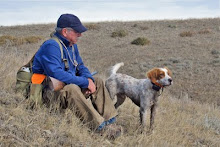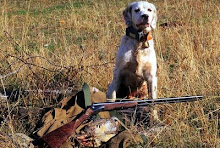 The term “unproductive” is used to indicate a point without a bird produced in front of the point. This often happens in both hunting and field trials. But the term covers a lot of situations – some are handler errors, some are caused by training, some are 'no fault', and some are on the dog.
The term “unproductive” is used to indicate a point without a bird produced in front of the point. This often happens in both hunting and field trials. But the term covers a lot of situations – some are handler errors, some are caused by training, some are 'no fault', and some are on the dog.A typical scenario... your dog is running well and to the front. He goes out of sight over a rise. Minutes later you top the rise and find your dog on point. You remain silent and go ahead to flush but produce nothing. At this juncture you might re-locate your dog to see if he can move forward and find the birds, re-establishing point. In a field trial this can carry some risk, since the birds may be close and the moving dog might flush them, and you are asked to pick-up your dog. Decision is yours, and if you know your dog well, you act accordingly. In a hunting situation, you probably want to release the dog to relocate.
But what happened here? Is the dog at fault? Some possibilities are:
1.The birds are there, but they didn't flush at your effort. Is a further effort required?
2.Your dog HAD the birds before you arrived, but they ran and/or flushed. This often happens with wild birds like grouse or Huns. In my opinion (voiced here before) the dog should relocate himself and avoid the UP. But if you trained your dog to hold point regardless of what happens, you could assume any possibility.
3.Your dog is pointing old scent and the birds were gone before the dog arrived. This is typical of a cautious dog, which could be a natural trait, a response to training, or a lack of experience. Some dogs become 'sticky' when natural caution and rigorous training combine and the dog seems to think, “I am not sure there is a bird here, but I am going to stop and point, rather than risk flushing a bird and getting in trouble.”
4.The birds flushed ahead of the dog and he has 'stopped to flush', and is awaiting release. You can usually determine this based on the dog's posture. Or not.
5.There were no birds here at all and the dog went on point for reasons unknown.
I have never seen a dog that didn't have an occasional UP, and I am never quick to blame the dog, relying on the old adage. “Trust the dog.” Nevertheless, I find it difficult to correct something without a reasonable idea of what caused the behavior.









4 comments:
Agree. I always try to give the dog the benefit of the doubt.
Nice post, Mike.
Andrew
When bird hunting I find the unproductive points rather helpful. The dog goes on point a few hundred yards away; it takes me a some time to walk there and I can study the terrain on the way. Where should I position myself to corral these birds and get the best opportunity for a clean shot? Where are the birds likely pinned, and where will they run? If the point is unproductive then I release the dog and I try to work into those likely areas. It's a dance with myself, the dogs, and the birds.
Post a Comment